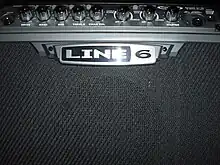Line 6 (company)
Line 6 is a musical instrument and audio equipment manufacturer, best known as a pioneer in digital amplifier modeling.[1] Their product lines include electric and acoustic guitars, basses, guitar and bass amplifiers, effects units, USB audio interfaces and guitar/bass wireless systems. The company was founded in 1996 and is headquartered in Calabasas, California.
 | |
| Type | Subsidiary |
|---|---|
| Industry | Amplification, Musical instruments |
| Founded | 1996 |
| Founder | Susan Wolf, Marcus Ryle and Michel Doidic |
| Headquarters | , |
Area served | United States, Europe, Japan |
| Products | Electric guitars, basses, amplifiers, effects units, USB audio interfaces, guitar/bass wireless systems |
| Parent | Yamaha Corporation |
| Website | line6.com |
History
Origin
Marcus Ryle and Michel Doidic (two former Oberheim designers) co-founded Fast-Forward Designs, where they helped develop several notable pro audio products such as the Alesis ADAT, Quadraverbs and QuadraSynth, and Digidesign SampleCell. As digital signal processing (DSP) became more powerful and affordable during the 1980s, they began developing DSP-based products which would emulate the tones of classic amplifiers, speaker cabinets, and effects. According to Ryle, the name "Line 6" came about because the phone system at Fast-Forward Designs only had 5 lines. Because the new guitar-related products were developed in secrecy, the receptionist used "Line 6" as a code word of sorts, and paging them for a call on Line 6 meant to stop any guitar or amp-related sounds so that they would not be overheard by other Fast-Forward clients or callers.[2]
Early offerings
Line 6 launched in 1996 with their first digital modeling amplifier, the AxSys 212, a combo amp using two 12" speakers. This was followed in 1997 by the Flextone[3] and in 1998 by the modeling software Amp Farm, which became popular among music producers and professional guitarists using Pro Tools.[4]
Fearing digital modeling was becoming beyond the reach of ordinary players, Line 6 sought to design an affordable, simple, standalone modeler with a unique look.[4] This led to the company's breakthrough product, the 1998 POD, a famously red, kidney bean-shaped desktop processor that emulated 15 classic amplifier models with multiple speaker cabinet options and onboard effects. Premier Guitar described the original POD as instigating "a long-overdue liberation" from cheap practice amps and expensive vintage amps. Line 6 subsequently expanded the POD into a family of products, with later additions increasing the line's amp choices and processing power.[4]
Line 6 has an active user community, and provides software that allows users to easily download and share patches or device settings for many of the company's products.
2000s
In early 2008, Line 6 acquired X2 Digital Wireless, who had introduced digital wireless systems for guitar.[5] Further developing this technology, Line 6 developed and introduced a family of digital wireless microphone systems in 2010.[6]
In December 2013, it was confirmed that Line 6 was to be bought by Yamaha Corporation, to operate as a wholly owned subsidiary with the internal management remaining the same.[7]
By the early 2010s, Line 6 had lost much of its prominence in the field of amp modeling to newer companies like Fractal Audio and Kemper, whose products offered greater processing power and better accuracy in emulating the tone and feel of conventional amplifiers. Designed over four years, Line 6 released its own high-end modeler, the Helix, in 2015.[1] It featured 72 amp models, 37 speaker cabinets, 16 microphone models, and 194 effects, all based around the company's newly developed HX engine.[8] The Helix has since expanded into a successful family of products, including the smaller HX Stomp and HX Stomp XL, and the Helix LT, with the diminutive Stomp consistently ranking as the top seller among all amp modelers and effects processors on Reverb.com.[8]
Line 6 products
Guitar amplifiers

Line 6 produces a number of guitar amplifiers (combos and heads), all featuring amplifier modeling software. In 2004, the Spider II 112 combo amp was released.[9] The Spider III sold over 12,700 units in 2011, the 15-watt Spider IV amp was the best-selling guitar amplifier in America.[10] According to their website, the Spider IV has also been the best-selling 15, 30, 75, and 120 watt amps. The latest model is the Spider V.[11]
Pedalboards/stomp boxes
Pedal boards range from POD amp modelers to modeling pedals for delay and other effects, as well as a jam looper. In 2015 Line 6 announced their "next generation" multi-effects processor/ pedalboard named Helix,[12] similar in function to the Floor Pod and Pod Live series, but with a redesigned interface and body.
Portable recording devices
The BackTrack and BackTrack+Mic are portable recording devices for electric and acoustic guitars, respectively.
Audio interfaces/effects processors
The earlier audio interface produced by Line 6, GuitarPort, is replaced by the TonePort line. POD amp modelers are available in a number of versions.
Musical instruments

Variax is a line of acoustic, bass and electric guitars. Some of the original development team members for the first Variax model introduced in 2002 moved on to other companies, including Damage Control USA and Vox Amplification Ltd.
Software
Line 6 software includes the Variax Workbench, a software application that can interface a home computer with a Variax electric guitar; the Gearbox, tone editing software; and Pod Farm, which contains all of the modeling features of the POD X3 emulated on the computer.
Wireless systems
In May 2008, Line 6 announced it had acquired X2 Digital Wireless;[5] it now sells wireless systems for guitar, bass, vocals and wind instruments. Spider V 60 MkII, Spider V 120 MkII, Spider V 240 MkII, Spider V 240HC MkII and POD Go wireless all feature built in wireless and are compatible with most Line 6 wireless transmitters.[13]
References
- Curwen, Trevor. "Line 6 Helix Review". musicradar.com. Music Radar. Retrieved 16 May 2023.
- http://www.prosoundnewseurope.com/main-content/full/the-lineage-of-line-6 Pro Sound News Europe, The Lineage Of Line 6
- Line 6. "Line 6". uk.line6.com. Retrieved 2019-11-10.
- Moore, Adam. "10 Years of the POD". premierguitar.com. Premier Guitar. Retrieved 16 May 2023.
- Line 6, Press Release, 2008-03-05. Acquisition of X2. Available at: https://line6.com/news/offers/649/ [Accessed April 19, 2023].
- http://www.prosoundnewseurope.com/main-content/full/the-lineage-of-line-6 The Lineage Of Line 6, Pro Sound News Europe, May 2010.
- http://uk.line6.com/news/pressReleases/1520 Official press release by Line 6
- Handley, Joel. "6 Years of the Line 6 Helix". reverb.com. Reverb. Retrieved 17 May 2023.
- "Line 6 Spider II – 112 Combo Amp Review". Guitarhoo!. Guitarhoo.com. July 7, 2004. Retrieved April 16, 2014.
- "Spider IV 15 – 30". Retrieved 9 January 2013.
- "Line 6 Products". Retrieved 22 January 2021.
- Line 6, 2015. Helix. uk.line6.com. Available at: http://uk.line6.com/helix/ [Accessed July 25, 2015].
- Line 6. "Line 6". line6.com. Retrieved 2022-08-11.
External links
- Official website
- Audio interview with Line 6 founder Marcus Ryle
- Marcus Ryle Interview at NAMM Oral History Collection (2007)
- Michel Doidic Interview at NAMM Oral History Collection (2011)
